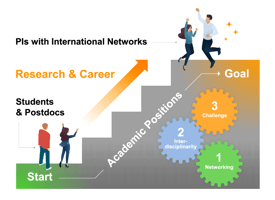Frozen grants. Labs on pause. Cancelled research projects.
The Trump administration’s war on science
Since the inauguration of President Donald Trump on January 21, 2025, the headlines have looked something like this…
Breaking News – January 22nd – Science: Trump hits NIH with ‘devastating’ freezes on meetings, travel, communications, and hiring
Breaking News – January 31st – NPR: National Science Foundation freezes payments
Breaking News – February 8th – Reuters: Trump recall of CDC research puts scientific papers in limbo
Breaking News – February 8th – The Guardian: Trump administration to cut billions in medical research funding
Breaking News – February 12th – The Guardian: Noaa imposes limits on scientists, sparking concerns over global forecasts
Breaking News – February 25th – Scientific American: Trump Orders U.S. Scientists to Skip Key Climate Meeting
Breaking News – March 11th – STAT News: Columbia scientists reel as Trump administration cancels grants, hitting broad suite of research
Breaking News – March 19th – The Associated Press: Trump Administration Aims to Eliminate E.P.A.’s Scientific Research Arm
Breaking News – April 4th – Nature: 16 US states filed suit over the termination of NIH grants
The current administration has taken never-before-seen steps that hinder the ability of scientists to receive funding, conduct research, and speak freely. In this article, we detail what exactly Trump has done to the world of research and how scientists are reacting.

Funding freezes
Immediately after the inauguration, the Trump administration began to issue a deluge of executive orders and memos, targeting “woke gender ideology;” diversity, equity, and inclusion (DEI); foreign aid; the “green new deal;” and support for “nongovernmental organizations that undermine the national interest.” Governmental agencies responded by temporarily suspending new awards, reviewing existing grants, and blocking access to funds.
This effect was immediately felt by institutions, which told their scientists to halt spending, leading to hardship among scientists. Some postdocs funded by the National Science Foundation (NSF) were left unable to pay rent and other bills.
Some agencies eventually reversed course after a judge blocked a January 27th White House memo intended to freeze a large block of federal spending. But overall, reductions to federal support have been largely implemented by agenciesranging from the NSF to the National Institute of Health (NIH). As a result, some universities have cut back offers of admission for new graduate students.
Changes to funding policy
In the end, the memos had most of their intended effects: in addition to cutting federal funding for science, new anti-DEI (Diversity, Equity, and Inclusion) restrictions were imposed.
Agencies reacted to and took on these orders each in their own way. NASA told its grantees and contractors to “immediately cease and desist all DEIA activities,” cutting a program that paired mission scientists with college students from underrepresented groups. The Department of Energy withdrew a requirement for researchers to include a plan for Promoting Inclusive and Equitable Research (PIER) in proposals and told its judges to ignore these plans in current evaluations.
Agency websites, from the NSF to Center for Disease Control (CDC) to the Environmental Protection Agency (EPA), scrubbed a long list of “banned” words from their websites, including “diversity,” “discrimination,” “gender,” “Native American,” “stereotype,” and “trauma.” Fermilab, the US’s particle-physics lab, suspended its DEI office and its women in engineering group. The Occupational Safety and Health Administration deleted web pages that simply mentioned the word “diversity”, even when the contents weren’t about DEI.
These changes have trickled into the private sphere as well, affecting groups unaffiliated with the U.S. government. For example, the American Geophysical Union had removed the word “diversity” from its site.
Science agency staffing
One additional change made by the current administration is to reduce the number of employees at federal scientific agencies.
Thus far, across a wide range of agencies, the federal government has eliminated the jobs of probationary workers (new hires who aren’t subject to the same protections as long-tenured employees). Major agencies also saw hundreds of terminations in the form of layoffs, including the National Nuclear Security Administration (NNSA) and the CDC. The CDC fired hundreds, including research fellows responsible for training public health laboratory staffers and supporting disease outbreak response efforts.
The NSF informed employees that they may have to lay off over half of its staff, and the U.S. Forest service indicated they would reduce their workforce by 10%—over 3,400 employees. The EPA placed 170 staffers on administrative leave, terminated a number of probationary employees, and told telework employees that they could no longer work from home.

The administration justified the move by saying that these cuts “were calculated decisions made to make our government more efficient without sacrificing on our ability to advance research and keep Americans safe.”
Universities strained
The orders from Trump on DEI sent waves through university administrations, who have had to decide whether or not to follow the directive set by the government. Some institutions, like Harvard University and the Massachusetts Institute of Technology, have already removed the requirement for job applicants to indicate how they will advance the goals of DEI. Others, like Mount Holyoke College, refused to abolish DEI, even at the risk of foregoing government contracts.
But there is a much more dire crisis sweeping through the world of academia: namely, an unprecedented funding crisis, causing universities to suspend and rescind admissions and job offers, and felling whole programs. So far, John Hopkins University has had to cut 2,000 jobs, Harvard University, Stanford University, University of Louisville and others have implemented hiring freezes, and the University of Pennsylvania, University of California San Diego, and others have reduced incoming PhD cohorts.
One of the major causes lies in a specific change to funding policy: the government refusing to fund indirect costs. Indirect costs cover no small number of essential costs for conducting research, such as maintaining buildings, utility bills, and support staff. As of February 7, the NIH capped indirect cost funding at a rate of 15% on its grants. The NIH estimated this move would save $4 billion each year by forcing universities, research institutes, and individual scientists to foot the bill instead.
Research affected
These changes, whether coming directly from the Trump government, from federal scientific agencies, or from universities, are having outsized effects on scientists and their ability to do research. Here are a few labs and scientists who spoke up about the risks to their research projects:
- Rick Huganir, a neuroscientist at John Hopkins, told NBC News that the new indirect cost rule could compromise his labs ability to begin a Phase 1 clinical trial. His research revolves around finding a cure for intellectual disabilities in children caused by mutations to the SYNGAP1 gene, which he discovered back in 1998.
- The University of Maine lost a grant that supported the research and salaries of twenty employees for their fishery-oriented research projects. Research projects supporting the seafood and fishing industries in ocean acidification, warming waters, and habitat conservation are now all threatened.
- Clarissa Henry, another University of Maine researcher, has depended on NIH funds to use zebrafish to research muscular dystrophy. In the process, her lab has overturned the existing consensus on exercise advice for MD patients, potentially saving lives in the process, but the Henry lab runs out of NIH funding in June.

Long term implications
The research community is united in their concerns about the threats posed by the Trump administration’s anti-science turn. But understanding the long-term consequences of the recent moves is a more complicated matter. Here are what a few insiders are saying about the ripple effects:
- Removing indirect cost funding will halt research. Several scientists emphasized that federal funding for indirect costs would not get replaced by other sources. David Skorton, president of the Association of American Medical Colleges (AAMC) said “not paying these reimbursed costs… will cause research operations to stop. The lights will go out, the people will be let go and these advances will not occur.”
- Talent will flee to other countries. Carole LaBonne at Northwestern University told NPR, “One place where you’re seeing the most immediate effect is on the trainees, who are the future of science in this country. Many are right now questioning the viability of being a scientist in the U.S. going forward. And who knows how many will end up…moving to another country, which could lead to further brain drain from the U.S..”
- The U.S. will lose an edge in scientific advancement. “If we don’t keep up, then, believe me, there’s plenty of work happening in Europe and in China,” Deborah Stine, founder of the Science and Technology Policy Academy, told NBC News. “We might lose the lead on an entire field of research.”
- The effects could be long lasting. One theoretical physicist at the University of Maryland, James Gate, predicted that it could take 50 years for U.S. science to recover from the setbacks.
Fighting back
Numerous lawsuits have burst out around the nation. In a major one, multiple state attorney generals are suing the NIH for the recent funding cuts. In the suit, the states argue that action violates the Administrative Procedure Act, passed during President Trump’s first term to fend off earlier proposals to cut research reimbursements. Another lawsuit led by the Association of American Universities (AAU) is taking the NIH to court for similar reasons.
Researchers and university leaders say that the biggest battle will be to convince the American public as well as Congress that science is worth the investment. At the very least, challenging these changes to American science has seen some bipartisan support: Republican Senators Katie Britt, Susan Collins, and Bill Cassidy have all pushed back against Trump’s plan to varying degrees.
Universities and research institutions will be in for a challenging few years. It will take all the persistence and innovation of the science world to stay the course.
Reach out to NewsRx here to stay updated on the new challenges and opportunities to the world of science and research.

.jpg?width=50&name=DSC_0028%20(1).jpg)

